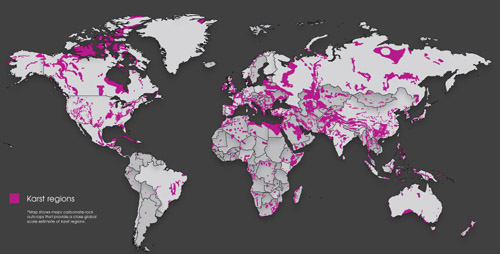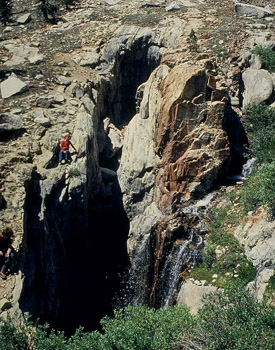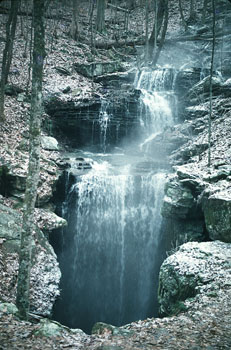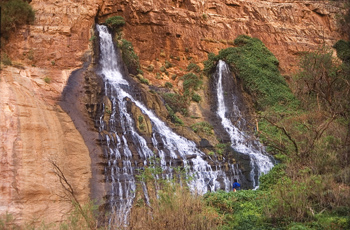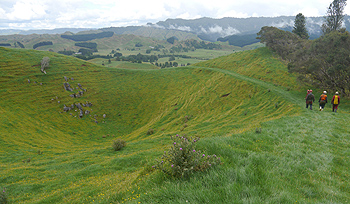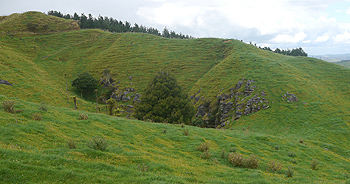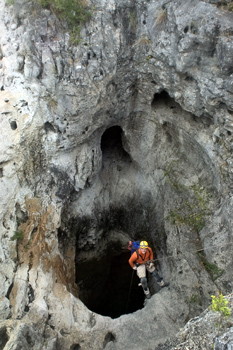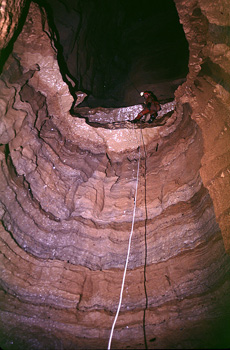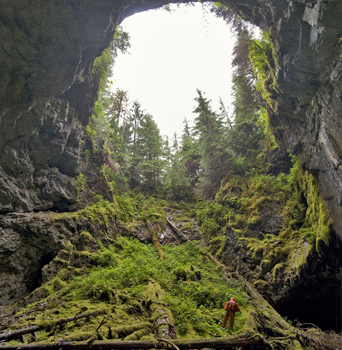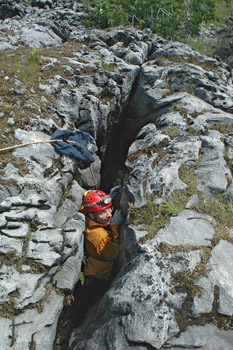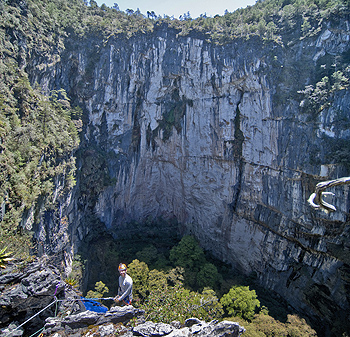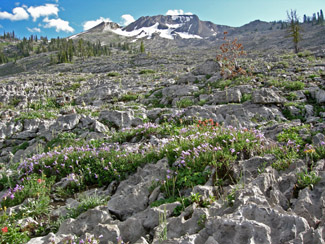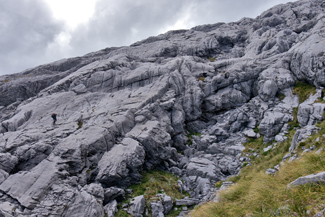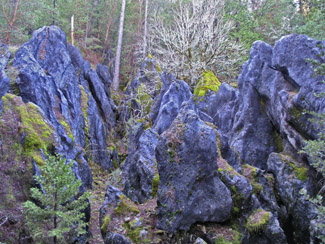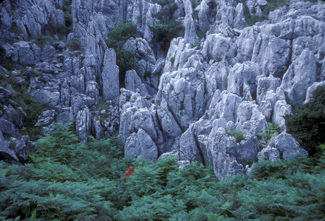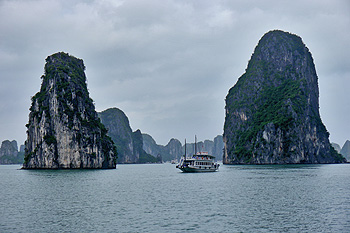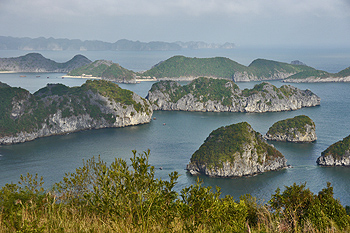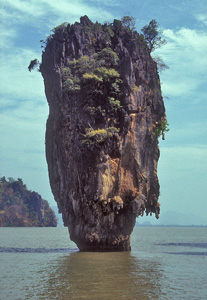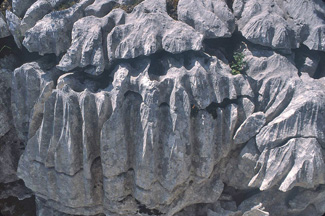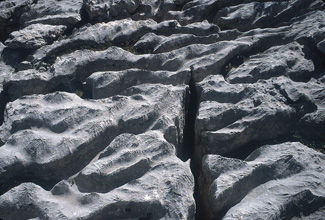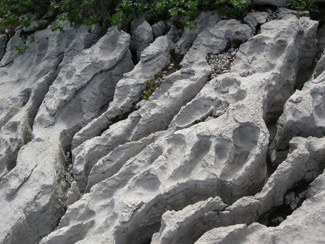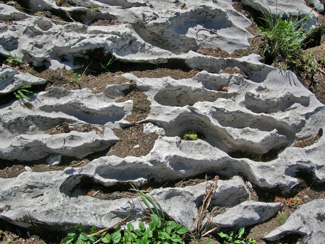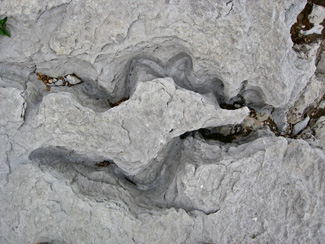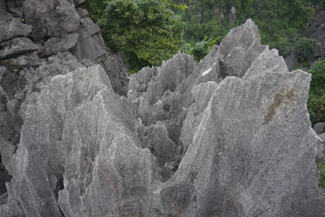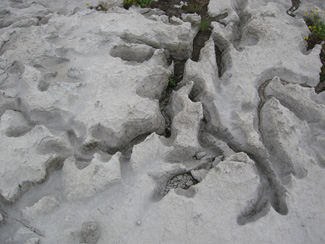

| Karst is a term used to describe the distinctive surface landscapes of cave country, shaped by dissolution of soluble bedrocks such as limestone, dolomite, or gypsum. The surface character of karst results from both surface dissolution of exposed bedrock and dissolution beneath the surface as caves are formed. Voids forming beneath the surface result in slumping or collapse. Streams sink underground and may not reappear until miles away as springs or birthplaces of rivers. Karst landscapes encompass some 10-15% of the earth's land mass and millions of people live in or among karst. This page will attempt to convey both the diversity and beauty of the world's karst. |
The Quintessential KarstWe begin with an image that absolutely screams "karst" because it is part of the actual landscape which gave rise to the name. Here, the river Reka flows through a large arch dividing two adjacent sinkholes. The river rises or resurges from a cave in the distant sink, its entrance just visible in the distance about the 4:00 direction from the church on the ridge. The river sinks again beyond. This scene is in the Škocjan Caves Regional Park in Slovenia. The region it is found has similar landforms throughout and is called Kras locally but karst in German. Now the term is used to refer to similar yet quite varied and beautiful landforms. At the top of the page is a karst ridge in central Laos near Vang Vieng. It also houses many caves. |
 Photo by Dennis Tang, Wikipedia Creative Commons Photo by Dennis Tang, Wikipedia Creative Commons |
Distribution of Karst: USACarbonate rocks are found in almost every state, with the exception of Delaware and Rhode Island. Not surprisingly the states with the largest amount of karst contain the most caves, with Tennessee the clear winner with over 8000 caves followed by Missouri with 4000+. In the map on the right one sees lava flows marked as "pseudokarst," because these landforms may contain features associated with karst such as caves (lava tubes), collapses and pits. However, there are not due to solutional processes and hence the "pseudo" part of the name. In Florida the karst is young and caves are actively forming below the water table; the longest cave systems there are still completely submerged and being explored by cave divers. The U.S. National Park Service has created a nice poster map showing all the park units with caves and karst. |
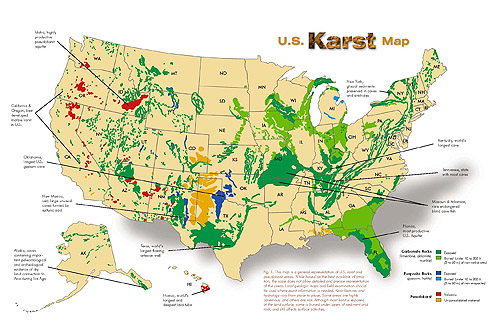 © 2001 American Geological Institute and reused here by permission. © 2001 American Geological Institute and reused here by permission. |
|
Resurgence from a large cave entrance. |
Springs and RegurgencesAll that water that sinks has to come out again somewhere. When it does we may call it simply a spring, which may form little more than a small pond. But a resurgence may also be a larger volume of water, even the birthplace of a river. Below is Vasey's Paradise, a major spring in the Grand Canyon emerging from the Redwall Limestone. |
A karst spring in Spain shows the deep blue color afforded by dissolved limestones. |
|
|
Pits and ShaftsA feature related to sinkholes is that of shafts and pits, otherwise known as "vertical" caves. In many cases these are basically sinkholes where collapse has led to steep sides. Often these may require rope to enter safely. The walls may be shear on all sides or have a debris slope as on the bottom left. Middle left, in a view from the bottom of a shaft, we can see the vertical grooves associated with erosion from surface water entering the pit. But the original enlargement probably occured below the water table. Top right, a pit in a heavily mantled (i.e. soil covered) karst. On the right are two examples of the extremes of the genre: A broad pit in Mexico, top, and a huge Tianxeng in China with a cave on the opposite wall. Often cave entrances in karst occur in the many fissures that form from solution. But there may be hundreds in a small area and most won't open into caves. |
Zoom in to see how huge this pit is - there is a climber on the far side, 650 feet from the camera. The pit is 633 feet deep.
This massive pit is 613 meters deep, and 600 x 420 meters across. It is exceeded in size by only one other Tiankeng, also in China. |
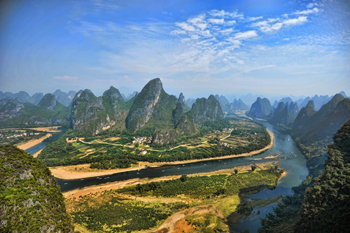 Photo by Chensiyuan, Wikipedia Creative Commons Photo by Chensiyuan, Wikipedia Creative Commons |
Karst Landforms: Cone KarstA mature karst form common to Southeast Asia is tower or cone karst. Rounded karst hills are typically classed as Fengcong when they cluser together and Fenglin when they occur as isolated cones surrounded by flat plains. |
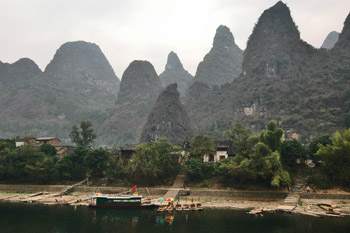 |
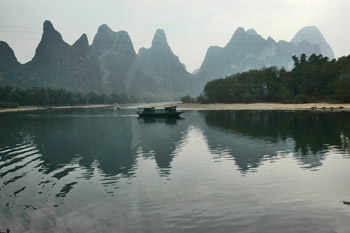 |
Perhaps the most famous and best developed of this form of karst is found in Guangxi Province, China. These images were taken from above or on the Li River, which cuts through the karst. In its flood plain are found more of the Fenglin, and further away are the larger mulit-peaked clusters of Fengcong karst. | 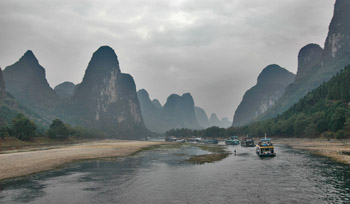 |
Karst Landforms:
|
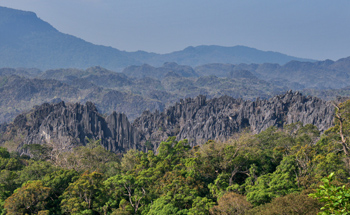 |
Karst Landforms:
|
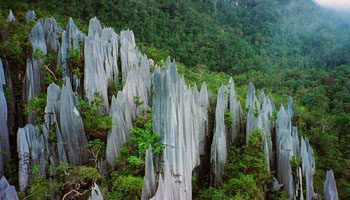 Photo by Paul White, Wikipedia Creative Commons Photo by Paul White, Wikipedia Creative Commons |
| Back to: | |
 |
Created: January 16, 2013 Author: Dave Bunnell |
